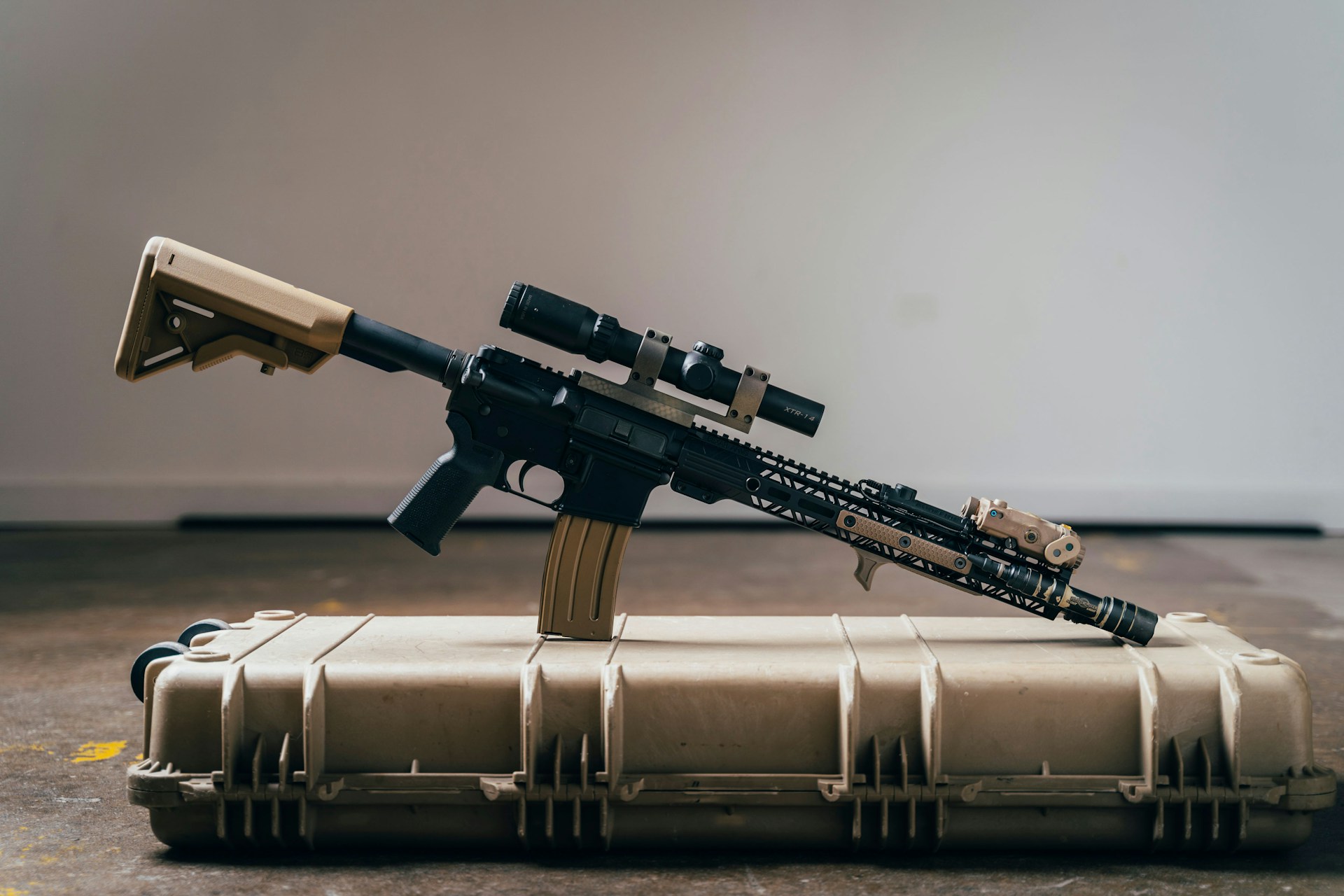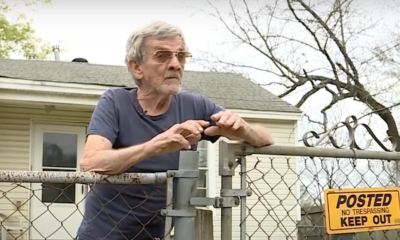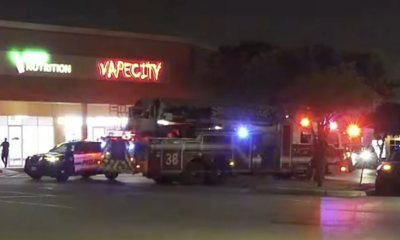Survival Stories
Unseen Advantage: Law Enforcement’s Rapid Adoption of Optics

In the world of law enforcement and survival, the ability to quickly and accurately assess a situation can make all the difference. This is why the rapid adoption of optics by law enforcement agencies is hardly surprising. These tools provide a wealth of visual information, aiding in making more informed decisions. A key factor in the selection of these optics is the window size, but it seems that co-witness sights, which can sometimes occupy half of the entire optic window, often don’t receive the attention they deserve.
“Without question, the speed with which LE agencies have adopted optics is testament to the advantage they offer: more visual information that yields better decisions.”
Interestingly, suppressor height sights are frequently paired with optics. To comprehend why this particular sight remains a popular choice when selecting co-witnessing sights, we must journey back in time. Around 2009, shooters, both professional and non-professional, began to repurpose a solution initially designed for Close Quarters Battle (CQB) rifle work for use on pistols.
The Trijicon RMR, a compact electronic optic, was a welcome alternative to the larger optics typically seen on competition pistols. Its smaller size offered more holster options, less likelihood of snagging in the field, and a more robust window and housing. As a result, it addressed many of the issues raised by professional users, leading to a shift towards an optics sighting solution within the firearms community.
“The smaller footprint meant more holster options, less to get caught on while in the field, and a less delicate window and housing.”
This shift was spearheaded by individuals in the military, law enforcement, defensive firearms instruction, and competition professionals. With the introduction of these optics, performance improved, and new shooters were able to develop accuracy and speed more quickly. The instinctual focal plane response to stress, which previously had to be trained out, could now be utilized as an asset by Firearms Instructors working with students who had optics on their pistols.
“Performance increased, accuracy and speed developed sooner with new shooters, the intuitive and instinctual focal plane response to stress no longer needed to be trained out—and instead, the threat-focus could now be an asset used by Firearms Instructors working with students who had optics on their pistols.”
As the popularity of optics grew, the aftermarket and firearms manufacturers responded by supporting this “new” sighting system. However, one critical component of the system was often overlooked: the back-up sights. This oversight highlights the need for a comprehensive approach to firearm optics, one that considers all elements of the sighting system to ensure optimal performance and safety.
Our Thoughts
The adoption of optics in law enforcement is a testament to the technology’s effectiveness. It’s no surprise that tools that enhance visual information, thus enabling better decision-making, have become a staple in the arsenal of law enforcement agencies.
The rise of the Trijicon RMR is particularly noteworthy. Its compact size and robust design addressed many of the practical concerns of professional users, leading to a broader acceptance of optics as a sighting solution.
The benefits of these optics extend beyond their practicality. They have brought about a shift in the training of new shooters, turning the instinctual focal plane response to stress into an asset rather than a hurdle to overcome. This has undoubtedly contributed to the improved performance observed among new shooters.
However, the focus on the main optic often results in the neglect of back-up sights. This is a reminder that a comprehensive approach to firearm optics is necessary to ensure optimal performance and safety. After all, a tool is only as good as the system supporting it.
Let us know what you think, please share your thoughts in the comments below.

Survival Stories
Mental Resilience: The Overlooked Key to Survival Success

In the realm of survival, we often focus on the physical aspects: the gear, the skills, the terrain. Yet, one crucial element often overlooked is our mental health. As a seasoned survivalist and a licensed mental health therapist, I’ve experienced firsthand the importance of mental resilience in a crisis.
I recall an incident during my first exploration of Red Rock Canyon. The vast, humbling landscape was a sight to behold, but it was also a formidable challenge. Despite my preparations, I found myself lost on a wild game trail, far from the intended path.
“Okay, no big deal,” I reassured myself. “I’ll just retrace my steps.”
But the creeping sense of panic was undeniable. I was low on water, surrounded by thick brush, and far from any signal. It was in this moment that my mental health training became as crucial as my survival skills.
“If anyone can figure this out, I can.” I thought. Or rather, tried to convince myself….
The human brain has a built-in survival mechanism known as the fight-flight-freeze response. When faced with danger, our heart rate increases, our pupils dilate, and our breathing becomes rapid. While these physiological changes can enhance our strength and speed, they can also lead to panic attacks, which can be detrimental in a survival scenario.
Soldiers and first responders are trained to manage this response, and so can civilians. Understanding mental health first aid can be a lifesaver in personal emergencies or when trying to calm someone else in a crisis.
“Okay…” I thought, “let’s just backtrack a little. See if I can’t find the main trail.”
I remembered the acronym S.T.O.P., taught in wilderness survival classes: Sit, Think, Observe, Plan. I sat down, focused on my breathing, and began to regain control of my racing thoughts.
“Breathe.” I thought. “In through the nose, slow. SLOW. Hold it for a few seconds. Now release through the mouth even slower. Pause. Repeat.”
I knew I had to control my thoughts to improve my feelings and make good decisions. Catastrophic thinking like “I’m gonna die” or “What if a rattlesnake bites me?” could trigger panic mode.
“Okay, what do we know?” I thought. “I know I can’t be too far off-course, no more than a couple miles. I know a few people knew generally where I was going (but not the specific trailhead) and that I expected to be back by nightfall. I know I have survival training and some kit with me that would help me make it through the night if needed. I can do this.”
After observing my surroundings and assessing my resources, I made a plan. I decided to head in the direction of what I believed to be a road, using a large branch to tap the ground in front of me to ward off any potential rattlesnakes.
In the end, I made it back to my vehicle without having to spend the night in the desert. The experience was a stark reminder of the importance of mental health in survival situations.
In the aftermath of a crisis, people will be in panic mode. Knowing how to guide someone through the stresses of a crisis can help mitigate some of the negative effects of traumatic events.
First, ensure the scene is safe. Then, assess the group, find helpers, and triage the situation. Ground the person by asking them to describe their surroundings and their feelings. Encourage slow, deliberate breathing and validate their experiences.
Long-term effects of repeated activation of the fight-flight-freeze response can include panic attacks, nightmares, and flashbacks. If you’re prone to these symptoms and find the techniques described here aren’t helping, consider seeking help from a licensed therapist.
Remember, it’s not a matter of being weak or strong. Some of the bravest individuals I’ve worked with have sought therapy for their symptoms. It takes great strength and bravery to ask for help.
Since my experience in Red Rock Canyon, I’ve incorporated mental health first aid and awareness into my survival teachings. I’ve also adjusted my approach to hiking, ensuring I communicate my exact route and expected return time, carry more water, and stay focused on the trail.
Survival isn’t just about the physical. It’s about the mental too. And with the right skills and mindset, we can navigate any crisis with resilience.
Our Thoughts
This compelling account underscores the often overlooked but critical role mental health plays in survival scenarios. The author’s experience in Red Rock Canyon drives home the importance of not just physical preparation, but mental preparedness as well.
The fight-flight-freeze response, while instinctual, can be detrimental if not properly managed. As survivalists, we should heed the author’s advice and learn to control this response, much like soldiers and first responders are trained to do.
The S.T.O.P. method is a useful tool in regaining control of our thoughts and feelings in high-stress situations. It’s not just about physical survival skills, it’s about mental resilience and clarity of thought.
Moreover, the importance of understanding mental health first aid cannot be overstated. It can be a lifesaver, not just for ourselves, but for others in crisis.
Ultimately, the author’s story is a reminder that survival isn’t just about the gear, the terrain, or the skills — it’s about the mind too. And in the face of adversity, with the right mindset, we can navigate through any crisis with resilience.
Let us know what you think, please share your thoughts in the comments below.
Survival Stories
Survival Essentials: Choosing and Mastering Your Firearm for the Wilderness

In the world of survival, the value of a reliable and accurate firearm cannot be overstated. Bradford Angier, a respected voice in the survival community and author of “How to Survive in the Woods,” once stated, “The best survival weapon, it follows, is a flat and hard shooting rifle. There is no need to append that it should be rugged, accurate, and durable.” This statement, penned in 1969, remains as true today as it was then.
In Angier’s era, the leading .22 rifles included the Armalite AR-7, Marlin model 60, Ruger 10/22, and Remington Model 66. Despite some of these models no longer being in production, they remain among the best survival firearms available today, and can often be found in excellent condition on used gun racks.
Angier’s writings also sparked a debate that continues to this day: if you could only have one gun, should it be a .22 for taking small game and allowing you to carry more ammo, or a larger centerfire rifle capable of taking down a larger animal for more substantial rations? This question remains a popular topic of discussion among survivalists.
Since Angier’s time, survival rifles have gained popularity, with many companies now offering models with features such as take-down capabilities, synthetic furniture, and adjustable stocks. The COVID pandemic and resulting meat shortages have also led to a surge in firearm ownership, as people consider the possibility of hunting their own food if supermarkets can’t provide.
However, owning a survival rifle is only part of the equation. Knowing how to use it effectively is equally, if not more, important. This includes understanding the fundamentals of marksmanship and knowing how to adapt to different shooting positions.
In the early 20th century, the three primary shooting positions were standing, kneeling, and prone. These positions offer varying degrees of stability, with prone being the most stable but also the most time-consuming to get into. More likely, shots will be taken while standing, sitting, or kneeling with the rifle supported against a tree or other object.
Training with a .22 rifle can be an effective way to practice these positions and make adjustments to your shooting technique. The recoil of a .22 is much less jarring than that of a larger centerfire rifle, making it a more comfortable option for sustained practice.
Each shooting position has its own advantages and trade-offs. For example, the prone position offers great stability but takes time to get into and can be uncomfortable in cold weather. The standing position is quick and allows for easy reloading but is less stable. In a survival situation, you may need to use variations of these positions, or even shoot from your non-dominant side.
Training should mimic real-world scenarios as closely as possible. This means using available objects for increased stability, such as a backpack or tree branch, and adjusting the size of your target as you move from more stable to less stable positions.
Training with a .22 rifle can also be a cost-effective way to improve your marksmanship. The cost of ammunition has risen significantly in recent years, making it more expensive to practice with larger centerfire rifles. The fundamentals learned with a .22 can later be applied to centerfire ammunition.
A survival rifle is a valuable tool for any survivalist, but knowing how to use it effectively is crucial. This includes understanding the fundamentals of marksmanship, being able to adapt to different shooting positions, and training in a way that mimics real-world scenarios. As Bradford Angier once said, the best survival weapon is a flat and hard shooting rifle, but it’s also important that it be rugged, accurate, and durable.
Our Thoughts
Bradford Angier’s wisdom about the value of a reliable, accurate firearm in survival scenarios still rings true. In today’s world, the importance of firearm adaptability, durability and accuracy is even more pronounced, given the uncertainties that we face.
The debate on whether to choose a .22 rifle for small game and larger ammo capacity or a centerfire rifle for larger game and substantial rations is a testament to the diversity of survival scenarios. This highlights the need for individuals to understand their specific survival needs and equip themselves accordingly.
The advancements in survival rifles, from take-down capabilities to adjustable stocks, demonstrate the evolution in survival gear. This evolution is driven by the need for versatility and adaptability in survival situations. The surge in firearm ownership due to the COVID pandemic also underscores the importance of self-reliance in uncertain times.
However, owning a firearm is just one part of the equation. The mastery of different shooting positions, understanding of marksmanship fundamentals, and the ability to adapt are key to survival. Training with a .22 rifle is an effective and cost-efficient way to hone these skills.
In conclusion, survival is about more than just having the right tools. It’s about the knowledge and skills to use them effectively. As survivalists, we must continue to adapt, learn and prepare for the unexpected.
Let us know what you think, please share your thoughts in the comments below.
Survival Stories
Lever-Action Rifles: Classic Meets Tactical in Modern Survival Gear

In the world of firearms, there’s a fascinating trend of old becoming new again. The lever-action rifle, once the tool of ranchers and cowboy action shooters, is experiencing a resurgence and evolution. Companies like Midwest Industries and custom houses like Mad Pig Customs are investing resources to modernize this often-overlooked platform.
“Why?” you might ask.
There isn’t a definitive answer. If you’re focused on practicality and cost-effectiveness, the modern semi-auto rifle with a detachable 30-round magazine has undeniable advantages. However, the updated lever gun, sometimes known as “the cowboy assault rifle,” has its merits.
A rifle with a manually cycled action and tube magazine can bypass almost any assault weapon restriction in the country. This makes the tactical lever gun an attractive option for those living in or traveling through areas with stringent gun laws, while still providing an accurate, powerful rifle with a range of modern accessories.
Caliber options for these rifles are diverse, ranging from rimfire to the formidable .45-70. The two rifles featured in this article are in .30-30 Winchester, a caliber known for its versatility in hunting and defense. With bullet weights typically ranging from 150 to 170 grains and muzzle velocities around 2,000 feet per second, the .30-30 has been used on nearly every game animal in North America.
Although not known for its long-range capabilities, it’s generally accepted as a 200-yard cartridge, which aligns with most mass-issue military calibers. Its trajectory and ballistic data is very similar to that of the 7.62x39mm Russian, the most widely used military caliber on the modern battlefield. While a lever gun lacks the capacity or rate of fire of an AK-type rifle, the .30-30 is in very good ballistic company when it comes to use in mixed terrain environments.
Preparation is an intensely personal pursuit. Some people don’t feel the need for the capacity or fire rate of a modern semi-automatic carbine. But many of those same people think it wise to have a firearm for the “just in case” scenarios. A lever-action rifle is easier to shoot than a pistol and has a longer range than a shotgun. Until a few years ago, choosing this option meant sacrificing easy access to modern enhancements like suppressors, weapon lights, electronic optics, lasers, modular grips, or adjustable stocks. Those days are over.
We’re showcasing two separate rifles, both built by Mad Pig Customs, each with different furniture and accessories. Mad Pig refinished each rifle in our preferred Cerakote colors, installed their signature lever and trigger parts, and performed a complete action job to ensure smooth and reliable functionality. We hope to shed some light on the myriad possible configurations available with a modernized lever-action rifle and prove once and for all that this platform hasn’t been relegated to history books.
The first rifle started life as a Marlin 30AW. No longer in production, the 30AW was meant as a more budget-friendly alternative to the flagship Marlin 336. With less expensive furniture material and less refinement in the fit and finish, the 30AW was truly a working man’s gun. The team at Mad Pig Customs stripped this rifle down to the skeleton and rebuilt it, starting with a Midwest Industries M-LOK handguard and a Form Stocks back end.
The second rifle has been a so-called “tactical” lever gun from day one. It started out as a Marlin 336 Dark Series, a special variant that was only available for a short time before Remington went bankrupt, ceased production of Marlin rifles, and sold the brand to Ruger. (Ruger recently announced the re-launch of the Marlin Dark Series, this time with a M-LOK forend and adjustable stock straight from the factory.)
One of the downsides of lever guns is their tube magazines, which make their manual of arms more like that of a shotgun than a modern bolt-action or semi-auto. While we’ve already touched on the idiosyncrasies of reloading, this also affects ammo carriage and load bearing. You won’t be carrying a box magazine in a belt pouch, so you’re left with tossing a fistful of loose rounds in your pants pocket — a compromise that’ll inevitably lead to slow, fumbled reloads — or seeking specialized ammo carriage equipment that’s a little harder to source. We found two companies who offer lever-gun-specific ammo pouches.
Wilderness Tactical offers a simple, low-profile solution called the ZipLoader. This is the equivalent of wearing an ammo butt cuff on your belt. It’s a simple nylon platform with 10 elastic loops for individual cartridges. We paired this with a small, zippered Bug Pack, also from Wilderness Tactical, which was used to carry loose rounds to replenish our other ammo carriers between drills.
For those who want a larger supply of organized ammo storage, or more flexibility for carriage, Grim Hunter Tactical makes two products we had the chance to evaluate for this article. The first is their Quick Loader Pouch, a fold-out pouch that carries 24 rounds. There are eight loops hard sewn to the outside of the pouch. Inside the pouch are two more tear-away “cards” that hold another eight rounds each, which attach to the inside of the pouch by hook-and-loop.
If your lever gun is your dedicated bugout or SHTF rifle, Grim Hunter offers a Lever Gun Chest Rig consisting of two Quick Loader Pouches and a third detachable pouch that can be used as a medical kit or admin pouch. On Grim Hunter’s website, you can choose to have your ammo pouches biased to the left or right side of the rig, based on personal preference. It’s available in a variety of colors with multiple harness options.
Finally, much like a shotgun, it may be advantageous to carry a few extra rounds on the gun itself for speed reloads. These can be carried on a traditional fabric or leather butt cuff or attached to modern M-LOK-mounted carriers such as those seen on our rifles.
While testing and training with our lever guns, we used Sellier & Bellot 150-grain soft-point .30-30 ammo.
The effectiveness of any tool is contingent on its user’s skill and experience, and our lever-action rifles are no different. The two of us have spent quite a bit of time training with AR-15s, but AR-15s these ain’t. Many of the fundamentals carry over — stance, grip, sight picture, trigger control, and so on. However, the manual of arms is drastically different from an AR, in addition to the reloading and ammo management challenges we mentioned earlier.
This led us to seek training from Lew Gosnell, an instructor who has amassed a variety of vintage and modern lever-actions and spent many years teaching students about the intricacies of these rifles. Gosnell is a Marine Corps veteran who also spent 31 years working in law enforcement on the streets of East L. A. These days, he teaches Defensive Lever Gun and other courses at Gunsite Academy in Paulden, Arizona.
In case you’re not familiar with Gunsite, it’s considered by many to be the mecca of firearms training in the United States, if not the whole world. Founded in 1976 by Lt. Col. Jeff Cooper as a location at which to teach his Modern Technique of the Pistol, Gunsite has evolved into an expansive facility with a wide range of pistol, rifle, shotgun, and even edged weapon classes.
It offers everything from classrooms and traditional range bays to run-and-gun Simulator courses, complex shoot houses, and vehicle-based training areas. It’s like an amusement park for shooting enthusiasts, complete with catered lunches, an on-site campground, and a museum built inside Cooper’s home.
After traveling to Gunsite and meeting Gosnell, we headed out to the 50-yard Hanneken range to start working with our lever guns.
The first order of business was to learn about manipulating the lever gun’s safeties. Both of our Marlin rifles feature manual cross-bolt safeties — Marlin calls it a Hammer Block Safety — but this feature is a relatively recent addition introduced in the early 1980s. Gosnell and many other lever gun users view this manual safety as redundant and excessive. Historically, the primary safety on an exposed hammer lever gun was the half-cocked position, pulled back halfway to full cock.
This prevented the hammer from resting against the firing pin, which could potentially fire a round if an object struck the hammer hard enough. It also prevented users from carrying the gun fully cocked and ready to fire at all times, which could lead to a negligent discharge if a foreign object touched the trigger.
To prepare our lever guns for a drill, we went through the following procedure:
* Half cock the hammer then engage the manual safety.
* Cycle the lever to chamber a round. The hammer is now fully cocked. (Top off the tube magazine with one more round if necessary.)
* With the manual safety still engaged and the gun pointed in a safe direction, place the firing hand thumb on the fully cocked hammer and apply pressure.
* Maintaining firm pressure on the hammer, press the trigger just long enough to carefully lower the hammer into the half-cocked position.
* Index the trigger finger safely on the side of the receiver and disengage the manual safety.
As soon as Gosnell gave the command to fire, we quickly thumbed our hammers back to fully cocked position and pressed the trigger.
In a way, the manual safety serves as training wheels — if a shooter lets the hammer slip while returning it to half cock, it prevents the gun from firing. But once we had done enough dry and live fire reps of this process to be fully comfortable with it, we left the manual safety disengaged and carefully returned our guns to half cock after firing. Always be careful to maintain a good grip on the hammer while returning it to half cock; this isn’t something that should be rushed. As Gosnell explained, this procedure may feel strange to us today, but it was the standard modus operandi for more than a century before the introduction of cross-bolt safeties.
Loading a lever gun is similar to loading a shotgun, but the placement of the loading gate on the right side of the receiver (as opposed to the underside) means you’ll have to load with your firing hand. Hold the gun in a low-ready position against the shoulder and press each round into the tube magazine until the loading gate closes behind it. Alternately, you can use a “violin load” position by resting the buttstock sideways over your shoulder, leaving the loading gate facing upward. Gosnell reminded us to keep our heads up and eyes downrange while loading to remain aware of potential threats.
Also like a shotgun, it’s OK to load a round directly into the chamber while the action is open. This can be useful for speed reloads in conjunction with a match-saver-style ammo carrier directly in front of the ejection port (as seen on both our rifles). However, be aware that lever guns can have trouble feeding if they’re operated at steep angles. So, don’t try to chamber load — or operate the lever at all — with the muzzle pointed at the ground.
To run the lever, be quick and forceful but deliberate. Babying it or failing to run the lever all the way forward may induce a malfunction. We also found that the angle of hand movement is important. Depending on your rifle and lever design, you may need to push your hand down, forward, or somewhere in between to achieve the smoothest action.
Once we were comfortable manipulating, loading, and firing our lever guns on the 50-yard range, we moved on to more complex challenges. After all, that manual of arms may feel comfortable on a flat range, but doing it while running, transitioning between multiple targets, and navigating around obstacles is a different story. This wasn’t just a lever gun class — it was a defensive lever gun class.
We started by setting up a barricade on the range, leaning out from either side to shoot without exposing ourselves more than necessary. Then, we ratcheted up a notch by heading down to The Pit, an indoor Simulator course that most of us would call a shoot house. We practiced clearing the structure, “slicing the pie” around doorways and corners to methodically take in every angle before proceeding.
Admittedly, we’d prefer a semi-auto rifle over a lever gun for these close-quarters applications, since thumbing back the hammer before firing and running the action between shots was tougher than just mashing a trigger. That said, our Mad Pig Marlins had no trouble getting repeatable, accurate hits on the threats in hallways, corners, and windows. The tall-mounted red-dot optics on both rifles were helpful for this purpose, offering a wide field of view and fast sight acquisition.
Next, we headed to Gunsite’s Military Crest, a winding trail with various natural shooting positions and an array of steel targets at distances of 100 to 200 yards or greater. We braced off trees and rocks, and used our rifles in standing, kneeling, and sitting positions. With a slight hold-over for the longer shots, we had no trouble ringing steel from each position. The only challenge we encountered was running the lever in positions where the rifle was rested on a flat surface, such as kneeling behind a stump; it may be necessary to lift or rotate the rifle to make room to move the lever. This is also why lever guns aren’t ideal for prone shooting.
For our final challenge, we moved to the Scrambler, a course that continued our work on positional shooting but added an emphasis on speed. With four rounds in our guns and a shot timer running, we sprinted between seven positions and shot steel targets while standing, kneeling, and sitting. Some stations had fallen logs or trees to use for support, but others required unsupported shots. This also tested our ability to load our rifles quickly while moving, and to carefully engage the half-cocked position after each hit — just like any other move-and-shoot drill, it’s essential to make your weapon safe before running ahead with it. By the end of the Scrambler, we were out of breath and grinning.
So, is it worth the effort to teach an old gun new tricks? Based on our experience with these two builds and our range time at Gunsite, we’d give an emphatic yes. While we certainly won’t deny there are more efficient, ergonomic, and cost-effective defensive weapons on the market, that doesn’t mean the venerable lever gun isn’t worth owning. And if it’s worth owning, it’s worth modifying and improving with aftermarket parts, just like your favorite semi-auto carbine.
These two modernized lever guns were built to deliberately push the envelope and become as AR-like (or “tactical,” if you prefer that term) as possible. They’re unabashedly extreme, like classic muscle cars converted into fire-breathing supercharged dragsters. You may not want a full M-LOK forend and adjustable stock for your lever gun, much less an infrared laser and night-vision-height optic mount, and that’s OK. Our intent was to show what’s possible using existing off-the-shelf components and a little fine-tuning in the hands of lever gun specialists at Mad Pig Customs. The result is a pair of rifles that never fail to stir up controversy on social media or draw a crowd at the local range. More importantly, they’re much more capable for dynamic shooting and defensive use than they were in unmodified form. Sorry, grandpa, you may not like it, but the future is now.
Our Thoughts
The resurgence of the lever-action rifle is a fascinating reflection of how history and innovation intertwine in the world of firearms. While the modern semi-auto rifle holds advantages in practicality and cost-effectiveness, the updated lever gun emerges as a viable option for survivalists, especially for those in areas with strict gun laws.
The versatility of the .30-30 Winchester caliber used in the featured rifles is noteworthy. Its ballistic data, similar to the widely used 7.62x39mm Russian, makes it a reliable choice for mixed terrain environments, despite the lever-action rifle’s limitations in fire rate and capacity.
The evolution of the lever-action rifle is a testament to the adaptability and creativity within the firearms industry. The modern enhancements to the classic design have expanded its range and functionality without sacrificing its historic charm.
The integration of tactical elements into the lever-action rifle, such as modular grips and adjustable stocks, is a significant step forward in transforming this platform into a more versatile tool for survivalists. It’s an exciting development that pushes the boundaries of what is possible with this classic firearm.
In conclusion, the lever-action rifle’s resurgence and evolution is a welcome trend that merges the past with the future. It’s a reminder of how, in the world of survival, practicality, and adaptability are key.
Let us know what you think, please share your thoughts in the comments below.
-

 Preparedness4 months ago
Preparedness4 months agoEx-Ballerina’s Guilty Verdict Sends Tremors Through Gun-Owner Community
-

 Tactical7 months ago
Tactical7 months ago70-Year-Old Fends Off Intruder with Lead-Powered Message
-

 Tactical7 months ago
Tactical7 months agoVape Shop Employee Confronts Armed Crooks, Sends Them Running
-

 Preparedness2 months ago
Preparedness2 months agoGood Samaritan Saves Trooper in Harrowing Interstate Confrontation
-

 Survival Stories1 year ago
Survival Stories1 year agoEmily’s 30-Day Experience of Being Stranded on a Desert Island
-

 Tactical7 months ago
Tactical7 months agoMidnight SUV Theft Interrupted by Armed Homeowner’s Retaliation
-

 Preparedness2 months ago
Preparedness2 months agoArizona Engineer’s Headless Body Found in Desert: Friend Charged
-

 Preparedness2 months ago
Preparedness2 months agoBoy Saves Dad from Bear Attack with One Perfect Shot